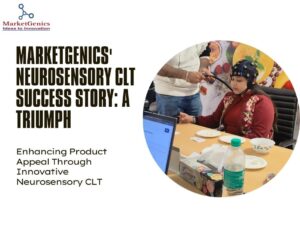For a reputable ingredient brand, MarketGenics conducted a Neurosensory Central Location Test (CLT) research. This study sought to identify the finer points of consumer perceptions and preferences, establishing a standard for taste and sensory assessments in the food business. Here’s a detailed look at how this CLT was executed, the feedback received, and the insights gained from this success story.

Blind samples and monodic sequential testing were used by MarketGenics to guarantee the accuracy and dependability of the findings. To ensure neutral feedback, participants, who ranged in age from 18 to 35, were served food that contained brand ingredients without any branding. In order to reduce any potential biases from evaluating products side by side, the monodic sequential technique allowed each participant to evaluate one product at a time in a sequential manner.
The CLT was conducted in controlled environments in Delhi NCR and Bangalore, providing a consistent setting for all participants. This approach allowed MarketGenics to gather in-depth data on consumer preferences and perceptions in real-time, with immediate feedback captured through advanced sensory evaluation tools.
MarketGenics ensured a representative sample of the consumer market by carefully selecting participants who fit the target demographic of 18 to 35 years old. The participants were further refined by identifying people with relevant taste profiles and preferences through pre-screening questionnaires.
In an organized assessment procedure, participants tasted the food and gave ratings on a range of sensory characteristics, including flavor, fragrance, texture, and general acceptability. Neurosensory instruments were utilized to record physiological reactions in real time, including biometric information and facial expressions, providing more profound understanding of their unconscious inclinations.
In order to compare the performance of the well-known food ingredient brand, a competing brand was used in the test. Thanks to participant input on both brands, MarketGenics was able to perform a comparative analysis.
The insights gained from the Neurosensory CLT enabled the food ingredient brand to fine-tune their product, ensuring it met the high expectations of their target demographic. The neurosensory approach provided a deeper understanding of consumer preferences, going beyond traditional sensory evaluation methods.
Advanced sensory evaluation techniques have great power in the food business, as demonstrated by MarketGenics’ Neurosensory CLT in Bangalore and Delhi NCR. Our client received actionable data from MarketGenics that fueled product excellence and competitive advantage. This success story not only highlights the capabilities of MarketGenics but also sets a new standard for sensory and taste evaluations in the market.

MarketGenics India is a MRSI certified company.
Send us your resume at
info@marketgenics.co
© 2025 MarketGenics India Pvt Ltd.; All rights reserved